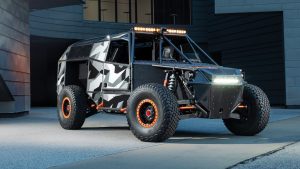University unveils newest student-built autonomous offroad rescue vehicle
August 19, 2024Clemson University unveiled its latest groundbreaking autonomous rescue vehicle, Deep Orange 15, on Aug. 13 at the Ground Vehicle Systems Engineering & Technology Symposium (GVSETS) in Novi, Michigan.

Deep Orange 15 comes equipped with an innovative litter-loading mechanism, a high-voltage battery, a rotating passenger seat to assist victims and a series hybrid powertrain.
Deep Orange 15, an advanced, high-speed, off-road, semi-autonomous search-and-rescue vehicle, is equipped with semi-active suspension, an innovative litter-loading mechanism, a high-voltage battery, a rotating passenger seat to assist victims and a series hybrid powertrain.
The vehicle is the 15th created as part of Deep Orange, Clemson’s flagship student vehicle prototype education program, where master’s students in the University’s Department of Automotive Engineering work with industry professionals to strategize on the customers’ needs, develop unique concepts and engineer and build each vehicle from scratch.
Sponsors of Deep Orange 15 are: Clemson’s Virtual Prototyping of Autonomy-Enabled Ground Systems program (VIPR-GS); U.S. Army’s DEVCOM Ground Vehicle Systems Center (GVSC); Brembo; Fox Racing; and North American Rescue.
With the support of these organizations, Clemson students apply research topics that not only help advance autonomy technology but also help students gain hands-on skills to expand their experience and knowledge.
Robert Prucka, the faculty lead on Deep Orange 15, said the team is excited to unveil the vehicle.
“Our Deep Orange students collaborated across an 18-month period to develop this autonomous, high-speed, off-road relief vehicle from the ground up,” said Prucka, the Alan Kulwicki Professor of Motorsports Engineering. “Getting the opportunity to show our work and research at the GVSETS symposium provides our students with an understanding of the significance of these new technologies and the opportunity they are receiving from being a part of the Deep Orange program.”
GVSC is a major Deep Orange sponsor and is hosting the symposium at which Deep Orange 15 is being unveiled.
David Gorsich, the chief scientist at GVSC, emphasized that the deployment of autonomous vehicles is a priority for the U.S. Army.
“Through our digital transformation, virtual prototyping and digital engineering practices will enable us to design ground vehicles from a formations perspective and understand how specific technologies provide warfighting capabilities up-front, long before we go into production decisions,” he said. “The modeling and simulation done at Clemson and the teamwork in programs like Deep Orange are exemplars of how the Army Futures Command shapes the future.”
The Deep Orange program at Clemson is set up to create advanced vehicles for the vehicle sponsor and prepare students for future success.
Among them is Anirudda Joshi, a student pursuing a master’s degree in automotive engineering and serving as the engineering project manager for Deep Orange.
“Deep Orange’s product is not only the vehicle but also the student,” Joshi said. “It has been an honor to take part in Deep Orange 15. The hands-on engineering experience is beyond anything we would have received from the classroom alone. We look forward to sharing what we have created.”
The focus is on all aspects of automotive engineering, which helps students develop and hone their skills to prepare them for jobs at major automotive original equipment manufacturers and their suppliers.
Following the graduation of the student team, the Deep Orange 15 vehicle will stand as a unique and advanced research asset for Clemson University, propelling it to the forefront of autonomous high-speed off-road research.
The vehicle will serve as a validation and verification tool for the complex dynamic modeling of autonomous vehicles in challenging terrains and as an advanced deployment platform for pioneering control algorithms and energy management strategies for off-road vehicles.
Here are some of the challenges Deep Orange 15 was designed to address:
Natural Disaster Relief and Reconnaissance Mission
● A natural disaster, such as a hurricane or an earthquake, changes the topography of the area and puts numerous people in immediate danger. The vehicle and two passengers must get to the scene within the golden hour (hour of time in which medical assistance is crucial for survival), create a digital map of the area, and make it back autonomously with the injured person and one passenger while the original driver stays behind at the scene to help others who are in need of assistance.
Off-Road Terrain Rescue Mission
● A dehydrated hiker is stranded in a rocky area with a broken leg and needs medical attention. The vehicle must get to the hiker through the rocky terrain and get back to its original location unmanned while the driver assists the hiker in the back of the vehicle on a rescue litter.

















